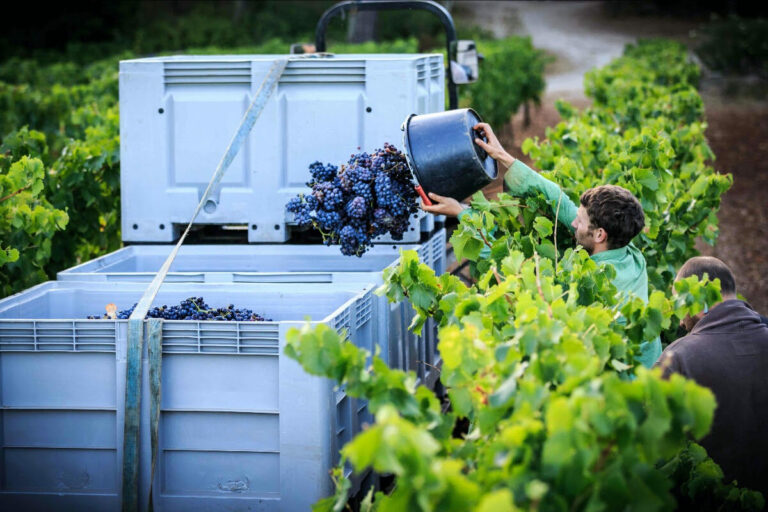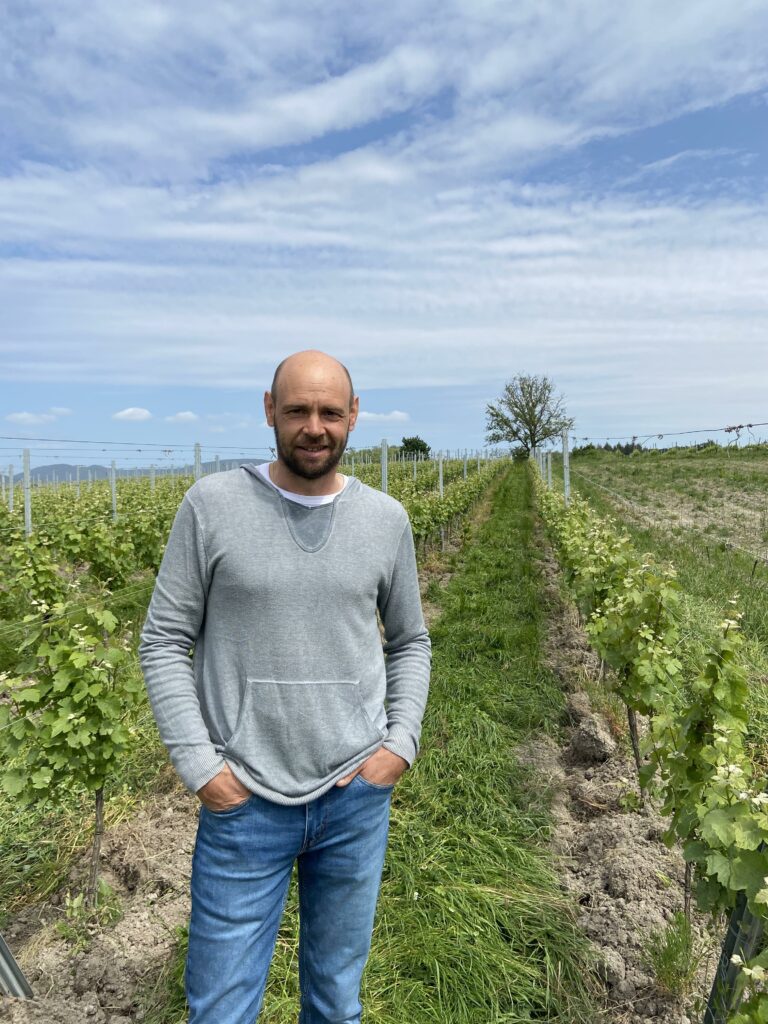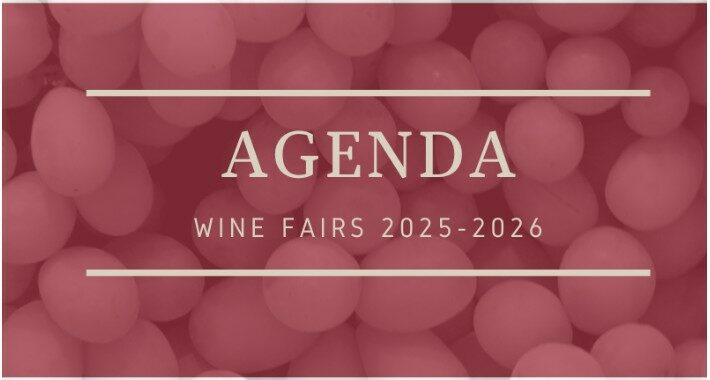
April 26, 2022
Epfig, Alsace
After two years of minimal travel no wine salons, a chance meeting at Wine Paris this year recently took us to the Alsatian vineyards!
This past February, we met Pierre Scharsch from the Bader estate and tasted his organic wines with him.
We were immediately charmed by the wines, struck by the duo of power and finesse in the whole range. The more we discussed with the winemaker, the more we were seduced by his approach in the vineyard to bring out as much potential as possible from his terroir through his wines and in the cellar, a perfect harmony of all the work over the year in the vineyard parcels.
This week, we bring you to the Bader estate, in Epfig, in the heart of the Alsatian vineyard, to meet Pierre Scharsch to discover more about his work.
In our report you will read :
- Location of the domaine
- The history of the domaine
- The terroir of the Bader vineyard
- Pierre Scharsch’s work in the vineyard and in the cellar
- The future projects
- Available Wines

Location Alsace : Epfig, Bas-Rhin
The estate covers 13 hectares in the commune of Epfig in the Bas-Rhin. It is an important wine-producing commune with 600 ha of vineyards. The vine has been present there for a very long time since it is said that the Roman troops would have planted vines there.
The village is located on a hill and the vines of the Bader estate are planted on hillsides at an altitude of about 300 meters or more on the plain.

History of the Domaine
In 2004, Pierre Scharsch took over the Bader estate, a family estate whose origins date back to 1642. Being himself from a family of winegrowers, he always wanted to work as a vigneron. Quite naturally, he decided to study viticulture and oenology in Burgundy.
When he settled at Domaine Bader, the estate covered 7 hectares and had to be completely restructured. Pierre proceeded in order to regularly replant the vineyard with local Alsatian grape varieties, taking into account the parcels of land and the nature of the soil.
For Pierre the choice to work in organic culture has always been clear. It is the way to allow the vine to produce its best expression according to its environment.
Thus, quite quickly after his installation, in 2010, the domaine took this turn to organics. Today, the estate has 13 hectares cultivated and certified organic since 2019. A biodynamic approach is initiated. It could, according to Pierre, help the vine to resist to all the current constraints, by offering an additional solutions to the plants.
His first harvest was vintage 2005, and the first bottling 2007. All the Alsatian grape varieties are planted: Sylvaner, Pinot blanc, gris and noir, Muscat, Riesling, Gewurztraminer and Chardonnay for the Crémants and a still wine outside the appellation.

Terroir and Viticulture Approach
The Alsatian climate is continental with hot summers and cold winters, the rainfall is low with 600 mm of rain on average because the vineyard is protected by the Vosges mountains.
Locally in Epfig, the climate is sunnier and more ventilated because the commune is just a little off the primary structure of the vineyard.
The whole of the 13 ha is fragmented. One part of the vineyard is on a hillside on siliceous marl and the other part is planted on the plain on deeper soils.
The cultural approach being organic, copper and sulfur are the only products to protect the vines from diseases. However, natural preparations are often used to complement the preparations. Depending on the situation, Pierre uses concoctions of horsetail, straw or nettles.
The use of orange-peel oil terpenes is limited to the most critical situations.
Concerning the soil work, several passages are made on the plough to control the competition. These tasks are completed with non-invasive tools, most often discs, because the repeated use of blades contributes to the formation of an asphyxiating ploughed soil.
Between the rows, the Autumn sowing is done with varieties of cereals and legumes, the crop cover obtained is rolled over at the end of Spring. This technique is favorable to the resilience of the soil.
Soil analyses are carried out every year on various plots at a rate that allows for one analysis per plot every 10 years. Data on the evolution of organic matter and biological activity are particularly important. Pierre believes that one cannot produce great wines in a soil that is not alive.
Harvest & Vinification
All the harvests are manual and carried out with about fifteen hand-harvesters over a period of about 3 weeks. Chardonnay grapes for the Crémants are the first to start the harvest, followed by the three Pinots, Muscat, Sylvaner and finally the Riesling and Gewurztraminer.
For some years, harvesting is done only in the morning until 1pm at the latest to avoid the afternoon heat.
The grapes are pressed when they arrive at the winery, a slow pressing of 6 to 9 hours. The must is cooled according to the vintage and the needs.
Fermentations are done in foudre and the style of the domaine is dry wines!
All vinifications are done in the historical cellar of the domaine, divided among the collection of foudres, some of them very old (dating from the end of the 19th century) and some stainless steel vats.
Only the Pinot family benefits from a partial barrel aging of the volume.
Pierre works with the Chassin cooperage in Burgundy, which gives good results for the whites and the reds.

Working with Lees
After alcoholic fermentation, the wines are aged on the lees, for which Pierre pays a lot of attention in order to use all their natural qualities during the maturation process.
During the alcoholic fermentation, oxygen can be added to avoid leaving the lees in an environment with too much reduction. At the end of the alcoholic fermentation, the wines are racked but the lees are kept in their entirety; they are put in a warm place to start the autolysis more quickly and then they are added to the wines during the ageing process which lasts between 6 and 12 months depending on the vintages. Stirring is done regularly.
This practice allows us to naturally obtain wines with elegance, aromatic richness and a silkier texture.

Future Projects
Pierre, like many winemakers, has several projects in mind to continue his quest for wines in which the Terroir best expresses itself.
In the cellar, he would like to use clay tanks in the future, especially with the Muscats Petits Grains and Alexandria, in order to let the aromatic delicacy of the varieties express itself even more.
In vinification, he is thinking of working with his chardonnays and pinot blanc without settling them in order to work with the entirety of grape’s material.
Available Wines

TASTING NOTES
Crémant d’Alsace
2/3 chardonnay and 1/3 PN aged 12 months on lattes. 13.2 % alc.
Nose: very nice intensity, white fruit (pear, peach), floral (white flower), delicate brioche
Very fine and delicate bubbles
Nice length
Pinot Blanc 2020
2/3 Auxerois vinified in stainless steel and 1/3 Pinot Blanc vinified in barrels
Nose : Nice intensity, light notes of smoke, enveloping nose
Discreet mouthfeel at the first taste and then opens up to white fruits, with a spicy finish
Muscat 2020
A blend of Muscat d’Alexandrie and Muscat petits grains planted on a beautiful terroir of siliceous marl, at an altitude of 300 meters. Wine matured on lees.
Nose : very delicate of rose, quince, apricot, medium intensity,
Palate : beautiful freshness, aromatic, round, rich, spicy finish of citrus fruits pepper.
Riesling 2019
Planted on sandier, well-draining soils, old vines (40-50 years), in the plain.
1st nose White flowers, then flint, graphite, then again floral, white fruit, cedar
Mouth with a nice saline freshness, mineral, spicy then warm, medium length, yellow flowers, licorice, mentholated.
Finish: yellow flowers and wisteria.
Riesling Erdengott 2019 (and 2020)
Old vines planted in 1947 on a quality terroir, sandy on the surface with depths of siliceous marl and layers of detrital sandy rock and limestone.
Graphite nose, petroleum, chestnut honey, then white flowers
Mouth with a very nice balance acidity / warmth
Pinot Gris 2020
With some passerillage harvested at 14.5
Vines planted in the middle of the hillside on richer, heavier, more textured soils.
Vinification for 50% stainless steel and 50% barrel, then bottled in the Spring
More discreet nose, with an ample mouthfeel of very ripe fruit, apricot, yellow peach, still spicy, slightly smoky.
Chardonnay 2020
Wine from France, aged in barrels for 1 year.
Light Vanilla aromas then more aromatic
Very beautiful mouth, dynamic freshness, ample mid-palate, toasted, pear, yellow lemon, white peach,
Nice length, always these sustained spices, sweet pepper spices
Pinot Noir 2020
Vines planted in the middle of the hillside on richer, heavier, more textured soils.
Wine vinified in stainless steel tanks.
Nose: a slight vegetal touch at the beginning opening on a very fruity mouth, cherry, raspberry, red currants. Very savoury finish.
A very generous wine!
Gewurztraminer 2020
Intense nose, notes of lychee, rose, melon, toast
Rich, round mouth, acacia, apricot, rose extract in the end, and again this beautiful spicy finish
Wine with residual sugars extremely well integrated
Gewurztraminer Vendanges Tardives 2018
Botrytized vines.
Nose of exotic fruits, mango, ginger,
Mouth with a soft and tense richness, very ripe apricot, mango, slightly bitter finish as papaya, honey, jasmine flowers
Beautiful and very clean finish.


